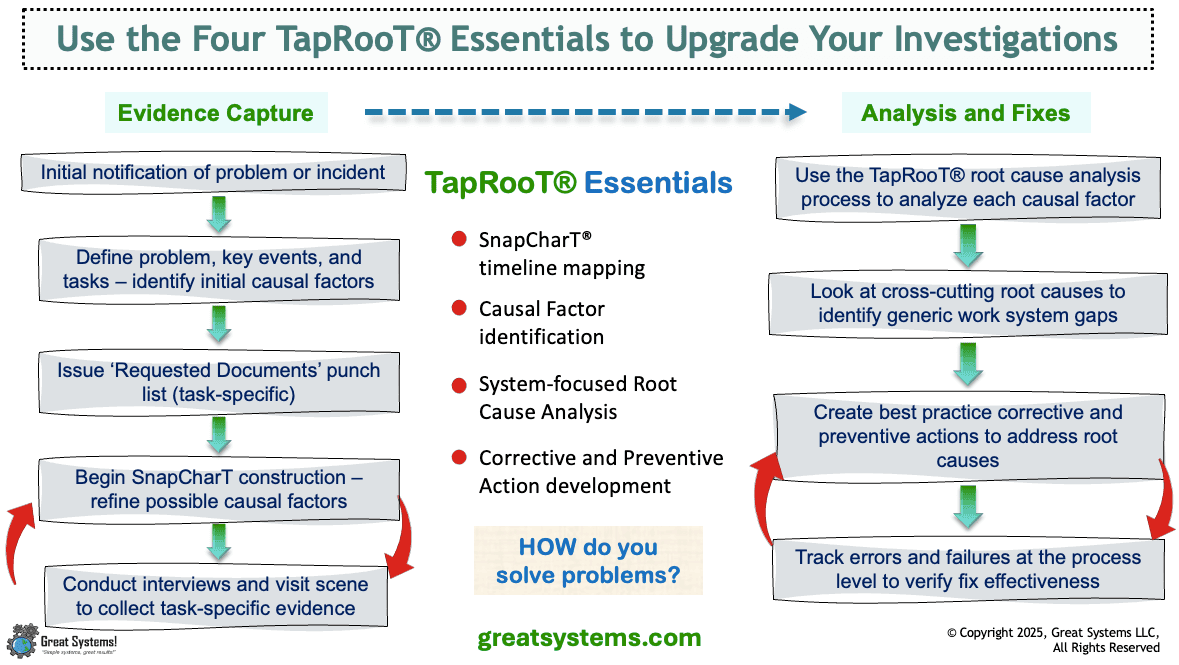TapRooT Virtual Root Cause Analysis Training

TapRooT® Virtual Root Cause Analysis Training!
How is TapRooT® virtual root cause analysis training different? This page explores some key differences in how Kevin McManus teaches this 3-day course as a contract instructor.
Since October 2020, I have only taught virtual workshops. This pivot comes after over 15 years of teaching 400-plus in-person courses around the world. My TapRooT virtual root cause analysis training experience (at least so far) tells me that the virtual product can be more effective than the in-person workshop versions I previously taught.
If your goal is to learn how to use the TapRooT® root cause analysis process both proactively and reactively, this course is for you. Over 35% of the course time is spent on the practice field, where we work on team exercises.
Plus, I help coach each team’s work to the degree that the team needs assistance. Also, I provide general exercise quality feedback to the class at the start of the second and third days of the course.
Since October 2020, I have only taught virtual workshops. This pivot comes after over 15 years of teaching 400-plus in-person courses around the world. My TapRooT virtual root cause analysis training experience (at least so far) tells me that the virtual product can be more effective than the in-person workshop versions I previously taught.
If your goal is to learn how to use the TapRooT® root cause analysis process both proactively and reactively, this course is for you. Over 35% of the course time is spent on the practice field, where we work on team exercises.
Plus, I help coach each team’s work to the degree that the team needs assistance. Also, I provide general exercise quality feedback to the class at the start of the second and third days of the course.
What makes the virtual teaching experience possibly more effective?
Enhancements to the course content make a huge difference. However, tech advantages exist for content delivery and emphasis that are tough to consistently replicate in an in-person classroom. This is especially true when the classroom is in a different location each week or is tough to access security-wise between classes.
Plus, I can more easily review, and provide feedback on, exercise work between classes. With the content spread over three days, there is also more time for such feedback. Previously, I often had no access to each team’s exercise work between course days. For privacy reasons, taking snaps of their work was not a sustainable alternative.
Plus, I can more easily review, and provide feedback on, exercise work between classes. With the content spread over three days, there is also more time for such feedback. Previously, I often had no access to each team’s exercise work between course days. For privacy reasons, taking snaps of their work was not a sustainable alternative.
This video compares the TapRooT root cause analysis process against the pros and cons of four other common root cause analysis tools. Please contact me if you would like to learn more about this process or take part in a virtual or onsite TapRooT cause analysis workshop.
WATCH over 50 kaizen and workplace health improvement videos on my Great Systems YouTube channel.
WATCH over 50 kaizen and workplace health improvement videos on my Great Systems YouTube channel.
Why should you attend or host TapRooT® virtual root cause analysis training?
To me, it is a matter of value. What do you get for what you spend? It is one thing to compare the cost of courses. More importantly, what are the associated travel costs? How many people, at how many different locations, need to be trained? How might travel and border restrictions complicate the training process?
Also, is it important to tailor the course content to your specific work process types? I have taught courses across a variety of workplace types. The cost to bring me into your work world is much less virtually. However, my motivation to help you succeed is just as great.
Also, is it important to tailor the course content to your specific work process types? I have taught courses across a variety of workplace types. The cost to bring me into your work world is much less virtually. However, my motivation to help you succeed is just as great.
How do we spend our time in a TapRooT® Virtual Root Cause Analysis course?
In the workshops I teach as a contract instructor for System Improvements, we spend roughly 40% of our time exploring the four essential concepts of the TapRooT® root cause analysis process. On the first day, we cover the first two essentials - SnapCharT® construction and causal factor identification. We cover the remaining two essentials, root cause analysis and corrective action writing, on the second day.
We work in breakout rooms for the remainder of our time, on two different exercises. One exercise is common to all. The second exercise is ideally one from your own work world. I try to keep the size of each group to two or three people. Anyone can practice on the software during the week of the course.
Plus, I am available for feedback on the process and course content during the entirety of the course. When I am with a group in their breakout room, other teams can summon me from the lobby. Conversely, individuals can leave their breakout room at any time and come chat with me in the lobby. The quiet virtual connection makes course-related conversation easy to have versus an active meeting room.
We work in breakout rooms for the remainder of our time, on two different exercises. One exercise is common to all. The second exercise is ideally one from your own work world. I try to keep the size of each group to two or three people. Anyone can practice on the software during the week of the course.
Plus, I am available for feedback on the process and course content during the entirety of the course. When I am with a group in their breakout room, other teams can summon me from the lobby. Conversely, individuals can leave their breakout room at any time and come chat with me in the lobby. The quiet virtual connection makes course-related conversation easy to have versus an active meeting room.
How can you maximize your benefits from the TapRooT® virtual root cause analysis workshop?
The goal of this 3-day course is to learn the four essentials of the TapRooT® root cause analysis process. Also, as you practice the use of each essential tool, you learn better root cause analysis questions to ask. Most importantly, you gain a deeper understanding of the tools you can use to better understand the systemic nature of your human and equipment performance difficulties.
Here are five ways you can get the most from one of the TapRooT® virtual root cause analysis courses that I teach:
* Bring a current workplace problem to class
* Engage fully in the software-based exercises
* Explore both the reactive and proactive ways in which you can use the TapRooT® root cause analysis process to improve performance
* Ask questions to take advantage of the in-class and post-class expertise
* Proactively practice the use of the TapRooT® root cause analysis process when you return to work
Here are five ways you can get the most from one of the TapRooT® virtual root cause analysis courses that I teach:
* Bring a current workplace problem to class
* Engage fully in the software-based exercises
* Explore both the reactive and proactive ways in which you can use the TapRooT® root cause analysis process to improve performance
* Ask questions to take advantage of the in-class and post-class expertise
* Proactively practice the use of the TapRooT® root cause analysis process when you return to work

LISTEN NOW to my 'Frequently Asked Root Cause Analysis Questions' Real Life Work podcast



